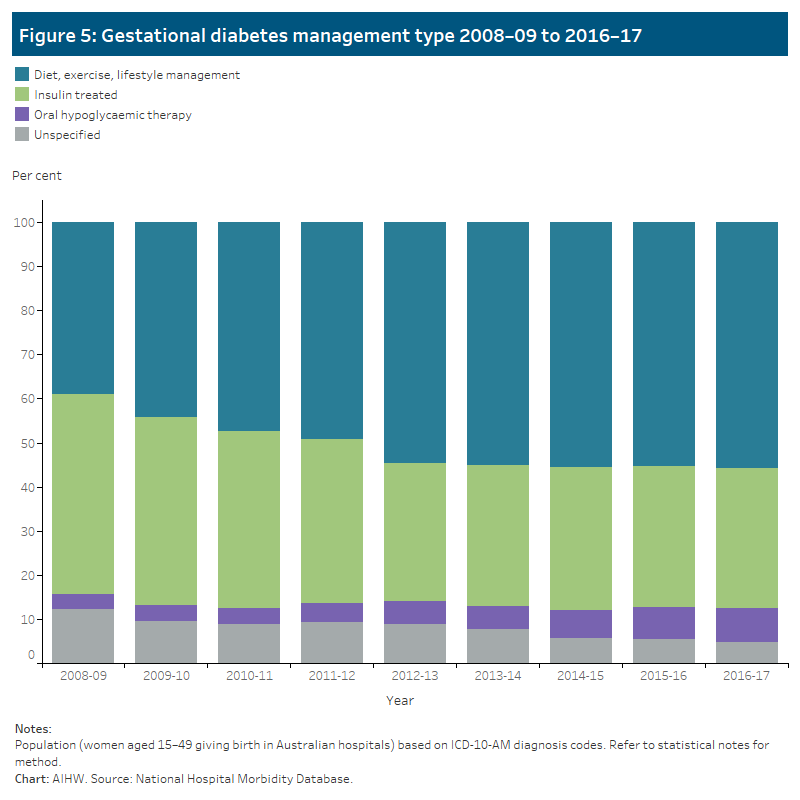Management
Of all women (aged 15–49) diagnosed with gestational diabetes in 2016–17, at the time of giving birth in hospital:
- More than half (56%) were recorded as having managed their condition without medication through the use of diet, exercise and/or lifestyle management.
- Just under a third (32%) had been treated with insulin therapy.
- 8% had been treated with oral hypoglycaemic (blood glucose lowering) medications, while the treatment of 5% remained unspecified (Figure 4).

Variation among population groups
Women treated with insulin for gestational diabetes were more likely to:
- be older—women aged 45–49 were 2.4 times as likely to be treated with insulin as women aged 15–19 (39% compared with 16%)
- be born in North Africa and the Middle East (39%) and Southern and Central Asia (38%) compared with 33% of Australian born mothers
- live in a Major city—33% of women with gestational diabetes living in a Major city were treated with insulin therapy compared with 24% of women living in Remote and very remote areas.
Women treated with oral hypoglycaemic medications were more likely to:
- be younger—women aged 15–19 were 2.2 times as likely to be treated with oral hypoglycaemic medications as women aged 45–49 (11% compared with 5%)
- Live in Remote and very remote areas—(20% compared with 7%–10%, respectively for women living in other areas)
- be socioeconomically disadvantaged—9% of women in the lowest socioeconomic group used oral hypoglycaemic medications compared with 6% of women from the highest socioeconomic group.
Women who treated their gestational diabetes through diet, exercise and/or lifestyle management were more likely to:
- be younger—women aged 15–19 were 1.3 times as likely to be treated without medication as women aged 45–49 (66% compared with 51%)
- be born in North-East Asia (72% compared with 53% of Australian born mothers)
- be in the highest socioeconomic group (59% compared with 54% of mothers from the lowest socioeconomic group).
See the Incidence of gestational diabetes data visualisation for further detail.
Aboriginal and Torres Strait Islander women
In 2016–17:
- just over half (52%) of Indigenous women diagnosed with gestational diabetes, managed their condition without medication through diet, exercise and/or lifestyle management. Almost one-third (29%) were treated with insulin therapy while 13% were treated with oral hypoglycaemic medications.
After adjusting for differences in the age structure of the populations:
- the use of insulin for the treatment of gestational diabetes was similar between Indigenous and non-Indigenous women (around one-third of cases)
- Aboriginal and Torres Strait Islander women were twice as likely to be treated with oral hypoglycaemic (blood glucose lowering) medications (14% compared with 7%).
Management trends
Between 2008–09 and 2016–17:
- the proportion of gestational diabetes cases treated with insulin therapy decreased from 46% to 32%—remaining unchanged at around 32% since 2012–13
- the proportion of gestational diabetes cases managed through diet, exercise and/or lifestyle management increased from 39% to 56%—remaining steady at between 55% and 56% since 2012–13
- the proportion of gestational diabetes cases treated with oral hypoglycaemic medications has continued to increase steadily from 3.5% to 7.6% (Figure 5).



